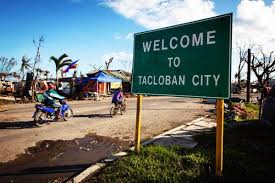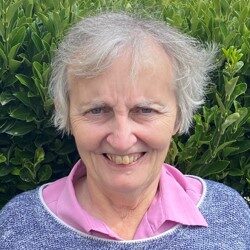In November 8th, 2013, Typhoon Haiyan (Yolanda), which was reported to be the strongest typhoon on record, ravaged the Philippines. Tacloban City was the hardest hit. The total number of deaths reported by the Government was six thousand, but it is widely believed that more than ten thousand people lost their lives in the storm. In September/October 2014 I was privileged to visit Tacloban to celebrate the Diamond Jubilee of their foundation from St. Maries of the Isle, Cork. One year later, the signs and scars of destruction were still very evident. It is also very real in the hearts and souls of the survivors, especially when one hears the story of their great losses and survival.

The campus of the Sisters of Mercy in Tacloban City, comprises of Holy Infant Convent, College and Mother of Mercy Hospital. The buildings of the convent, the college and the newly established hospital were either totally or partially destroyed. Roofs and walls gave way to the strong winds while facilities such as computers, laboratory and medical equipment, books and office materials were mostly destroyed. Other Mercy schools in the region, Assumption Academy, Tanauan, Leyte, Holy Child High School, Villaba, Cathedral High School of La Naval, Biliran also suffered greatly.
Tacloban City Airport and the surrounding areas were partially wiped out. The airport itself now has some new structures, rather temporary, but work is still in process. As we touched down from Manila, one could see that the area was more like a desert, with vegetation still sparse, and in the distance one could see that the tops of the coconut trees were literally blown away – these will never again bear fruit, thus, many families are without their livelihood. On the way from the airport to the convent, there was evidence of some temporary buildings. Many little houses are still without a roof, some were being repaired, others literally knocked to the ground and beyond repair. Along the way, families were still living in tents waiting for the Government to provide accommodation. Some has been provided but it is a slow process, so many families were left with nothing.
During my visit, the Sisters shared their experiences and stories of what it was like for them after the storm. The most difficult part was the death of thousands of people. Bodies were littered on the streets for weeks until they were eventually buried in mass graves. These mass graves are very evident, marked with little clusters of white crosses in various places around the city and on the roadside between Tacloban, Tanauan and Palo. They are a constant reminder as you move around.
In the immediate aftermath of the storm, around two to three hundred people took refuge in the convent. For days they had neither food nor water as all the supplies had run out. These were only available at the airport. Once the Sisters were able to get gasoline for the ambulance, three of them went to the airport to request and secure food and water for these people. Supplies were brought to the school and this then became a distribution point for local families. Foreign aid, such as food, clothing and materials for tents eventually began to reach the people. They were then encouraged to start to rebuild their lives.
You will recall, Sr. Mary Reynolds, Director of Mercy International Association, appealed to the Global Mercy Community for support and help for Mercy in the Philippines. The response to that appeal was phenomenal. This was really the starting point in helping the Sisters to realize that they were not alone. They took courage and hope from the support promised to them. Immediately after the storm, they wondered if they would ever be able to continue their Mercy ministry in Tacloban, as the impact of the task of rebuilding seemed impossible. The financial support pledged by MIA, and other donors, encouraged them to begin the work of repairing the buildings. The Sisters themselves said:
‘We were helped to rise up, put out trust in the Lord, as Catherine McAuley often did, and decided to steer ahead and do what was needed to be done’
Their first task was to clear the debris. Repair and refurbishment continued for months and still continues. The financial support given by MIA enabled this work to be done. Repair work is still ongoing.
Shortly after the typhoon German doctors came to work in the hospital. Their first task was to clear the place before they could begin treating patients who were coming for help. They also carried out a survey where they identified some special needs. A boy of eleven years of age, who was unable to walk due to a knee injury was identified for special surgery. They undertook this case, and he is now able to walk, and has returned to school after an absence of three years. The Sisters were in a position through the support given from Ireland, to provide a home for this family as they had lost everything in the typhoon. The German doctors also suggested that more space was needed, and through support given from Humidica (Germany) another floor has been added to the Hospital. This was blessed on Mercy Day 2014. The hospital is now fully occupied.
The past pupils of Tacloban, living in the US made contact with Caritas Germany. They now support the Sisters with the final stages of refurbishing the schools, and have helped in the restoration of the library, by supplying books and other equipment. The restoration of Holy Infant College, Assumption Academy, the hospital and the convent was a mammoth task and how the Sisters managed it in such a short time is astounding. They referred to the visit of Sr. Mary Reynolds as a very special blessing for them. It reassured them that they were not alone.
The people who were housed in the school after the typhoon are generally very poor with no permanent source of income. Their livelihoods range from driving pedicabs to operating sari-sari stores (small retail stores). These families lost everything in the storm. As the Sisters were anxious to support them in getting their lives together, they did a house to house survey to see how best they could support and help them. Two projects were identified:
Pedicab Assistance Project

The Pedicab Programme is managed by the purchase of pedicabs which are then ‘rented’ to the beneficiaries. The beneficiary enters a contract whereby he pays a small rent for the pedicab. Over a twenty-one month period it serves as his payment for the pedicab, which he then owns.
Backyard Assistance Project

The Backyard Assistance Programme consist of providing a family with ‘a piglet’. The family rears the piglet which is sold after three months. The earnings are halved between the beneficiary and the donor. From the earnings, other piglets are purchased and other families are supplied. While I was there, I visited many of these families and it is evident that these projects made a great difference to their lives.
I was privileged to be there for the special celebrations for the Diamond Jubilee of the arrival of the Sisters of Mercy to Tacloban. The Sisters were also celebrating the 90th anniversary of the foundation of Holy Infant College. The Sisters and the people of Tacloban were overjoyed with my visit and were extremely grateful to the Sisters of Mercy and their donor friends for the very generous help given to them. They felt that my visit gave them the opportunity to personally thank the donors. The staff in Holy Infant College put it this way:
‘We lost our homes, our relatives, our school, our livelihood. The help from Ireland has given us back our school and our livelihood and we hope that very soon we will be able to get our homes back’.
Living and sharing life with the Sisters in the Philippines for those few weeks was a life giving experience for me. It was good to be among them for that short visit, and for this I am deeply grateful. On their behalf, I wish to thank all who supported them in their time of great need.
Rita Twomey rsm
Southern Province


